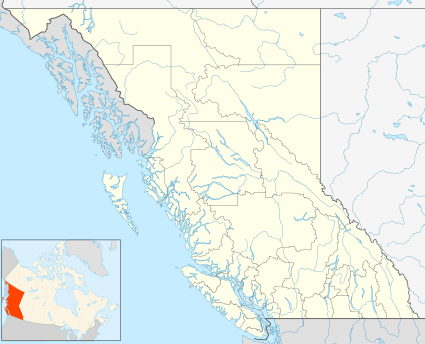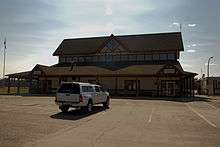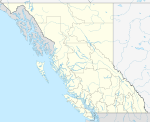Quesnel, British Columbia
Quesnel /kwɪˈnɛl/ is a city located in the Cariboo Regional District of British Columbia, Canada. Located nearly evenly between the cities of Prince George and Williams Lake, it is on the main route to northern British Columbia and the Yukon. Quesnel is located at the confluence of the Fraser and Quesnel Rivers. Quesnel's metropolitan area has a population of 23,146 making it the largest urban center between Prince George and Kamloops.[2]
Quesnel | |
|---|---|
| City of Quesnel | |
.jpg) The Quesnel gold pan, claimed to be the largest in the world, welcomes visitors from the north in its old location. | |
 Flag | |
| Motto(s): "Quesnel: It's in our nature"[1] | |
 Quesnel Location of Quesnel in British Columbia | |
| Coordinates: 52°58′42.4″N 122°29′33.6″W | |
| Country | Canada |
| Province | British Columbia |
| Region | North Cariboo |
| Regional district | Cariboo Regional District |
| Founded | 1861 |
| Incorporated as Village | 1928 |
| Incorporated as Town | 1958 |
| Incorporated as City | 1981 |
| Government | |
| • Mayor | Bob Simpson |
| • Governing body | Quesnel City Council |
| Area | |
| • City | 35.38 km2 (13.66 sq mi) |
| • Metro | 21,751.30 km2 (8,398.22 sq mi) |
| Elevation | 474 m (1,555 ft) |
| Population (2016) | |
| • City | 9,879 |
| • Density | 279.2/km2 (723/sq mi) |
| • Metro | 23,146 |
| • Metro density | 1.1/km2 (3/sq mi) |
| Time zone | UTC−08:00 (PST) |
| Forward sortation area | V2J |
| Area code(s) | 250, 778, 236 |
| Highways | |
| Waterways | Bowron Lake Fraser River, Quesnel River |
| Website | http://www.quesnel.ca/ |
Quesnel is a sister city to Shiraoi, Japan. Quesnel hosted the 2000 British Columbia Winter Games, an annual provincial amateur sports competition. To the east of Quesnel is Wells, Barkerville, and Bowron Lake Provincial Park, a popular canoeing destination in the Cariboo Mountains.
History
Long before the arrival of prospectors during the Cariboo Gold Rush of 1862, the Southern Carrier (Dakelh) people lived off the land around Quesnel, occupying the area from the Bowron Lakes in the east to the upper Blackwater River and Dean River in the west. The Southern Carrier Nation were known among themselves as ‘Uda Ukelh’, meaning ‘people who travel by boat on water early in the morning’.[3] The name "Quesnel" is derived from Jules Maurice Quesnel, who accompanied Simon Fraser on his journey to the Pacific Ocean. Quesnel came to be called 'Quesnelle Mouth' to distinguish it from 'Quesnel Forks', 97 kilometres (60 mi) up river. In 1870, it had been shortened to Quesnelle and by 1900, it was spelled the way it is now. Quesnel is located along the gold mining trail known as the Cariboo Wagon Road and was the commercial centre of the Cariboo Gold Rush. It also marks one end of the Alexander MacKenzie Heritage Trail. Because of its location on the Fraser River, it was also an important landing for sternwheelers from 1862 to 1886 and then, from 1909 until 1921. The last sternwheeler on the upper Fraser was Quesnel's own namesake craft, and home town product, the Quesnel. Quesnel was incorporated in 1928.
Geography and climate
- Location: 52°58′42.4″N 122°29′33.6″W
- Elevation: 474 m (1,555 ft)
- Average annual snowfall: 177.9 cm (70.0 in)
- Average annual rainfall: 540.3 mm (21.3 in)
- Frost free days: 179
- Average winter temperature: −8.6 °C (16.5 °F)
- Extreme minimum temperature: −46.7 °C (−52.1 °F)
- Average summer temperature: 16.7 °C (62.1 °F)
- Extreme maximum temperature: 40.6 °C (105.1 °F)
- Time Zone: Pacific Time Zone
Climate
Considering it is located inland and around the 53rd parallel north, Quesnel's humid continental climate[4] (Dfb) is mild by Canadian standards, being subject to marine airflows from the Pacific. Overnight lows are still cool even in summer, but daytime temperatures average above 24 °C (75 °F) in that season according to Environment Canada.
The highest temperature ever recorded in Quesnel was 40.6 °C (105 °F) on 17 July 1941.[5] The coldest temperature ever recorded was −46.7 °C (−52 °F) on 31 December 1927 and 17 January 1950.[6][7]
| Climate data for Quesnel Airport, 1981–2010 normals, extremes 1892–present[lower-alpha 1] | |||||||||||||
|---|---|---|---|---|---|---|---|---|---|---|---|---|---|
| Month | Jan | Feb | Mar | Apr | May | Jun | Jul | Aug | Sep | Oct | Nov | Dec | Year |
| Record high °C (°F) | 16.1 (61.0) |
18.9 (66.0) |
22.3 (72.1) |
31.1 (88.0) |
36.5 (97.7) |
36.7 (98.1) |
40.6 (105.1) |
38.3 (100.9) |
36.1 (97.0) |
28.3 (82.9) |
24.4 (75.9) |
18.3 (64.9) |
40.6 (105.1) |
| Average high °C (°F) | −2.9 (26.8) |
1.3 (34.3) |
7.3 (45.1) |
13.5 (56.3) |
18.4 (65.1) |
21.7 (71.1) |
24.1 (75.4) |
24.1 (75.4) |
18.5 (65.3) |
10.8 (51.4) |
2.1 (35.8) |
−2.3 (27.9) |
11.4 (52.5) |
| Daily mean °C (°F) | −6.9 (19.6) |
−3.6 (25.5) |
1.3 (34.3) |
6.4 (43.5) |
11.1 (52.0) |
14.7 (58.5) |
16.8 (62.2) |
16.4 (61.5) |
11.5 (52.7) |
5.5 (41.9) |
−1.4 (29.5) |
−5.9 (21.4) |
5.5 (41.9) |
| Average low °C (°F) | −10.8 (12.6) |
−8.3 (17.1) |
−4.7 (23.5) |
−0.8 (30.6) |
3.7 (38.7) |
7.6 (45.7) |
9.5 (49.1) |
8.6 (47.5) |
4.5 (40.1) |
0.2 (32.4) |
−5 (23) |
−9.6 (14.7) |
−0.4 (31.3) |
| Record low °C (°F) | −46.7 (−52.1) |
−45.6 (−50.1) |
−38.9 (−38.0) |
−21.7 (−7.1) |
−11.1 (12.0) |
−7.8 (18.0) |
−1.1 (30.0) |
−2.6 (27.3) |
−11.1 (12.0) |
−28.4 (−19.1) |
−37.8 (−36.0) |
−46.7 (−52.1) |
−46.7 (−52.1) |
| Average precipitation mm (inches) | 47.8 (1.88) |
22.7 (0.89) |
24.9 (0.98) |
24.5 (0.96) |
42.6 (1.68) |
66.4 (2.61) |
65.6 (2.58) |
46.2 (1.82) |
50.2 (1.98) |
52.6 (2.07) |
51.3 (2.02) |
41.6 (1.64) |
536.2 (21.11) |
| Average rainfall mm (inches) | 10.4 (0.41) |
6.7 (0.26) |
12.7 (0.50) |
21.2 (0.83) |
41.4 (1.63) |
66.4 (2.61) |
65.6 (2.58) |
46.2 (1.82) |
50.2 (1.98) |
46.3 (1.82) |
22.3 (0.88) |
4.9 (0.19) |
394.3 (15.52) |
| Average snowfall cm (inches) | 44.0 (17.3) |
19.0 (7.5) |
13.4 (5.3) |
3.6 (1.4) |
1.2 (0.5) |
0.0 (0.0) |
0.0 (0.0) |
0.0 (0.0) |
0.0 (0.0) |
6.7 (2.6) |
31.5 (12.4) |
42.8 (16.9) |
162.1 (63.8) |
| Average precipitation days (≥ 0.2 mm) | 12.8 | 9.7 | 9.7 | 9.8 | 12.1 | 15.8 | 14.2 | 12.0 | 12.4 | 14.8 | 14.0 | 13.4 | 150.7 |
| Average rainy days (≥ 0.2 mm) | 3.1 | 3.4 | 5.9 | 8.8 | 11.9 | 15.8 | 14.2 | 12.0 | 12.4 | 13.7 | 7.2 | 2.4 | 110.8 |
| Average snowy days (≥ 0.2 cm) | 11.3 | 7.1 | 5.4 | 2.2 | 0.7 | 0.0 | 0.0 | 0.0 | 0.0 | 2.4 | 8.8 | 11.8 | 49.7 |
| Average relative humidity (%) (at 15:00 LST) | 74.3 | 62.0 | 46.9 | 37.9 | 40.0 | 44.8 | 44.4 | 42.9 | 49.4 | 59.0 | 72.6 | 75.7 | 54.2 |
| Source: Environment Canada[7][8] | |||||||||||||
Demographics
Quesnel had a population of 9,879 people in the 2016 census, which was a decrease of 1.2% from the 2011 census count. The median household income in 2015 for Quesnel was $60,651, which is slightly below the British Columbia provincial average of $69,995.[9]
As of 2018, the population of Quesnel is estimated to be a little over 10,000 people living within the city, with roughly 13,000 people living outside the city limits but within the metro area.[10]
| Canada 2016 Census | Population | % of Total Population | |
|---|---|---|---|
| Visible minority group Source:[11] |
South Asian | 510 | 5.3% |
| Chinese | 100 | 1% | |
| Black | 20 | 0.2% | |
| Filipino | 90 | 0.9% | |
| Latin American | 20 | 0.2% | |
| Arab | 0 | 0% | |
| Southeast Asian | 0 | 0% | |
| West Asian | 10 | 0.1% | |
| Korean | 10 | 0.1% | |
| Japanese | 60 | 0.6% | |
| Other visible minority | 10 | 0.1% | |
| Mixed visible minority | 10 | 0.1% | |
| Total visible minority population | 830 | 8.6% | |
| Aboriginal group Source:[12] | First Nations | 755 | 7.8% |
| Métis | 770 | 8% | |
| Inuit | 45 | 0.5% | |
| Total Aboriginal population | 1,610 | 16.6% | |
| White | 7,245 | 74.8% | |
| Total population | 9,685 | 100% | |
Administration
Quesnel's city government consists of a seven-member council, that is one mayor and six Councillors. The current city council, elected in 2018 for a four-year term, is composed of Mayor Bob Simpson and Councillors Scott Elliott, Tony Goulet, Ron Paull, Laurey-Anne Roodenburg, Martin Runge, and Mitch Vik.[13]
Education
Quesnel is part of School District 28, which contains several elementary schools, as well as a Junior and a Senior Secondary School (Quesnel Junior High School and Correlieu Senior Secondary School respectively). Also, within the school district is McNaughton Centre which is an Alternate High school. For post secondary education, Quesnel has the College of New Caledonia and University of Northern British Columbia shared campus, which offers several programs, including four year nursing and social work degrees, foundation or apprenticeship-level trades certification, health sciences, human services, academic upgrading, or industry and continuing education courses. The Quesnel CNC Campus also offers students the chance to start arts or sciences degrees and then, transfer to university.
Transportation
Quesnel is served by the Quesnel Airport, with several commercial flights daily to and from Vancouver, BC. The city has a local transit system provided by BC Transit.
Tourism
Quesnel's tourism industry is largely based on the city's access to nature, with hunting and guiding outfitters, fishing, hiking, canoeing.[3] The Rocky Mountaineer, a rail-tour train also travels through and stops overnight in Quesnel.
Quesnel's history as a gold-rush town is also reflected, as there are over 30 heritage sites around the city.[14] Quesnel is home to the world's largest gold pan,[15] measured at 5.5 m in diameter and weighing 1400 kg, although this is disputed by Nome, Alaska. The Gold pan currently resides downtown near the museum.
Culture
There are twenty-three decorated fire hydrants in the streets of Quesnel. This work was sponsored by the local businesses in the vicinity of the hydrants.[16]
.jpg) Carson Avenue and Kinchant Street
Carson Avenue and Kinchant Street.jpg) McLean Street and Shepherd Avenue
McLean Street and Shepherd Avenue.jpg) McLean Street and St Laurent Avenue
McLean Street and St Laurent Avenue.jpg) Shepherd Avenue and Kinchant Street
Shepherd Avenue and Kinchant Street
Sports
Quesnel is home to the Central Interior Hockey League's Quesnel Kangaroos Senior AA hockey team. The team plays at the West Fraser Centre in Quesnel. The city was formerly home to the Quesnel Millionaires, a BCHL team, before they relocated to Chilliwack as the Chilliwack Chiefs in 2011.
Quesnel also has soccer, airsoft and paintball, minor baseball, softball, lacrosse, ringette, roller derby, and football leagues. A Mountain biking skills park is located behind the Rec Center and West Quesnel has a skateboard park.
Notable people
- Rory MacDonald – Mixed martial artist currently with Bellator MMA in the Welterweight division
- Bob Gassoff – former National Hockey League player (St. Louis Blues)
- Brad Gassoff – former National Hockey League player (Vancouver Canucks)
- Errol Rausse – former National Hockey League player (Washington Capitals)
- Aaron Gagnon – former National Hockey League Player (Dallas Stars & Winnipeg Jets)
- Brett Festerling – former National Hockey League Player (Anaheim Ducks & Winnipeg Jets)
Neighbourhoods and nearby communities
- West Quesnel
- Uplands
- Riverview
- West Riverside
- South Quesnel
- Southhills
- Red Bluff
- Dragon Lake
- Rich Bar
- North Quesnel
- Carson Sub
- Johnston Sub
Nearby communities, not part of the City of Quesnel, include:
- Moose Heights
- Ten Mile Lake (also locally referred to as Parkland)
- Barlow Creek
- West Fraser / Narcosli
- Cottonwood
- Nazko
- Bouchie Lake
- Kersley
Notes
- Climate data was recorded at Quesnel from November 1892 to April 1970 and at Quesnel Airport from February 1946 to present.
References
- "Short commutes, affordable housing: Quesnel rebrands itself to attract disenchanted Lower Mainland residents". CBC News British Columbia. 17 January 2017. Retrieved 25 April 2019.
- "Population and dwelling counts, 2016 Census". Statistics Canada. Retrieved 28 October 2019.
- "Explore Quesnel – It's in our nature". www.tourismquesnel.com. Retrieved 30 October 2017.
- "Quesnel, British Columbia Climate Summary". Weatherbase. Retrieved 22 October 2015.
- "Daily Data Report for July 1941". Canadian Climate Data. Environment Canada. Retrieved 21 December 2016.
- "Daily Data Report for December 1927". Canadian Climate Data. Environment Canada. Retrieved 21 December 2016.
- "Quesnel A". 1981–2010 Canadian Climate Normals. Environment Canada. Retrieved 20 December 2016.
- "Quesnel". Canadian Climate Data. Environment Canada. Retrieved 20 December 2016.
- "Census Profile, 2016: Quesnel". Statistics Canada. Retrieved 28 October 2019.
- "BC Stats Has Released Population Numbers For The Cariboo". My Cariboo Now. Retrieved 13 December 2019.
- "Community Profiles from the 2011 Census, Statistics Canada – Census Subdivision". 2.statcan.gc.ca. 6 December 2010. Retrieved 13 April 2013.
- "Aboriginal Peoples – Data table". 2.statcan.ca. 6 October 2010. Retrieved 13 April 2013.
- "Quesnel City Council". City of Quesnel. Retrieved 28 October 2019.
- "Quesnel". www.hellobc.com/quesnel.aspx. Retrieved 30 October 2017.
- "BC's Biggest Attractions Are Often in the Smallest Places". BC Lodging & Campgrounds Association. Retrieved 28 October 2019.
- "Painted Fire Hydrant Walking Tour". City of Quesnel. Retrieved 7 March 2020.
- "Arts and Recreation: Shiraoi House". City of Quesnel. Retrieved 25 April 2019.
External links
| Wikimedia Commons has media related to Quesnel. |
| Wikivoyage has a travel guide for Quesnel. |

